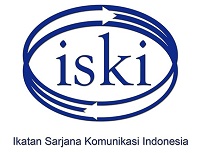Chance and Hindrance for Elder Toward Digital Inclusion: a Literature Review
Abstract
Keywords
Full Text:
PDFReferences
Bappenas. (2019, August 29). Pemanfaatan Demografi Indonesia di Sektor Kepariwisataan, Kebaharian, dan Ekonomi Kreatif. https://www.bappenas.go.id/files/11c5b418-7d16-463a-9b62-310085b5bd3d/download
Barsasella, D., Liu, M. F., Malwade, S., Galvin, C. J., Dhar, E., Chang, C.-C., Li, Y.-C. J., & Syed-Abdul, S. (2021). Effects of virtual reality sessions on the quality of life, happiness, and functional fitness among the older people: a randomized controlled trial from Taiwan. Computer Methods and Programs in Biomedicine, 200, 105892.
BBC. (2019, April 7). Dunia punya lebih banyak “kakek-nenek” dibandingkan cucu-cucu, apa dampaknya? https://www.bbc.com/indonesia/majalah-47804425
BPS. (2019). Proporsi Indvidu yang Menggunakan Internet Menurut Kelompok Umur (Persen), 2017-2019. https://www.bps.go.id/indicator/27/1228/1/proporsi-individu-yang-menggunakan-internet-menurut-kelompok-umur.html
BPS. (2021, October 11). Statistik Telekomunikasi Indonesia 2020. https://www.bps.go.id/publication/2021/10/11/e03aca1e6ae93396ee660328/statistik-telekomunikasi-indonesia-2020.html
Castells, M., & Cardoso, G. (1996). The network society (Vol. 469). Oxford: Blackwell.
Castilla, D., Botella, C., Miralles, I., Bretón-López, J., Dragomir-Davis, A. M., Zaragoza, I., & Garcia-Palacios, A. (2018). Teaching digital literacy skills to the elderly using a social network with linear navigation: A case study in a rural area. International Journal of Human-Computer Studies, 118, 24–37.
Chaudhuri, A., Flamm, K. S., & Horrigan, J. (2005). An analysis of the determinants of internet access. Telecommunications Policy, 29(9–10), 731–755.
Cooper, H. M. (1984). Cooper, Harris M., The Integrative Research Review: A Systematic Approach. Beverly Hills, CA: Sage, 1984.
Demoussis, M., & Giannakopoulos, N. (2006). Facets of the digital divide in Europe: Determination and extent of internet use. Economics of Innovation and New Technology, 15(03), 235–246.
Demunter, C. (2005). ICT SKILLS MEASUREMENT IN EUROSTAT’S INFORMATION SOCIETY STATISTICS. Journal of the European Union, L183.
Fernández, M. D. M., Hernández, J. D. S., Gutiérrez, J. M., Escuela, M. R. H., & Fino, E. R. (2017). Using communication and visualization technologies with senior citizens to facilitate cultural access and self-improvement. Computers in Human Behavior, 66, 329–344.
Fox, S. (2001, September 9). Wired Seniors. https://www.pewresearch.org/internet/2001/09/09/wired-seniors/
Galle, M. D., Borg, W. R., & Gall, J. P. (1996). Educational research. White Plains, NY: Longman.
Gallistl, V., & Nimrod, G. (2020). Media-based leisure and wellbeing: a study of older Internet users. Leisure Studies, 39(2), 251–265.
Guner, H., & Acarturk, C. (2020). The use and acceptance of ICT by senior citizens: a comparison of technology acceptance model (TAM) for elderly and young adults. Universal Access in the Information Society, 19(2), 311–330.
Guo, Z., & Zhu, B. (2022). Does Mobile Internet Use Affect the Loneliness of Older Chinese Adults? An Instrumental Variable Quantile Analysis. International Journal of Environmental Research and Public Health, 19(9), 5575.
Hargittai, E., & Dobransky, K. (2017). Old dogs, new clicks: Digital inequality in skills and uses among older adults. Canadian Journal of Communication, 42(2).
Holt, B. J., & Morrell, R. W. (2002). Guidelines for web site design for older adults: The ultimate influence of cognitive factors. Older Adults, Health Information, and the World Wide Web, 109–129.
Hunsaker, A., & Hargittai, E. (2018). A review of Internet use among older adults. New Media & Society, 20(10), 3937–3954.
Hunsaker, A., Nguyen, M. H., Fuchs, J., Karaoglu, G., Djukaric, T., & Hargittai, E. (2020). Unsung helpers: older adults as a source of digital media support for their peers. The Communication Review, 23(4), 309–330.
Khalili-Mahani, N., Assadi, A., Li, K., Mirgholami, M., Rivard, M.-E., Benali, H., Sawchuk, K., & de Schutter, B. (2020). Reflective and reflexive stress responses of older adults to three gaming experiences in relation to their cognitive abilities: mixed methods crossover study. JMIR Mental Health, 7(3), e12388.
Kim, Y. S. (2008). Reviewing and critiquing computer learning and usage among older adults. Educational Gerontology, 34(8), 709–735.
König, R., Seifert, A., & Doh, M. (2018). Internet use among older Europeans: an analysis based on SHARE data. Universal Access in the Information Society, 17(3), 621–633.
Kurt, A. A., Günüç, S., & Ersoy, M. (2013). The current state of digitalization: Digital native, digital immigrant and digital settler. Ankara University Journal of Faculty of Educational Sciences (JFES), 46(1), 1–22.
Lera-López, F., Izquierdo, M. G., & Billón-Currás, M. (2009). El uso de Internet en España: Influencia de factores regionales y socio-demográficos. Investigaciones Regionales-Journal of Regional Research, 16, 93–115.
Loges, W. E., & Jung, J.-Y. (2001). Exploring the digital divide: Internet connectedness and age. Communication Research, 28(4), 536–562.
Martínez-Alcalá, C. I., Rosales-Lagarde, A., Alonso-Lavernia, M. de los Á., Ramírez-Salvador, J. Á., Jiménez-Rodríguez, B., Cepeda-Rebollar, R. M., López-Noguerola, J. S., Bautista-Díaz, M. L., & Agis-Juárez, R. A. (2018). Digital inclusion in older adults: A comparison between face-to-face and blended digital literacy workshops. Frontiers in ICT, 5, 21.
Mills, B. F., & Whitacre, B. E. (2003). Understanding the Non‐Metropolitan—Metropolitan Digital Divide. Growth and Change, 34(2), 219–243.
Mohan, G., & Lyons, S. (2022). High-speed broadband availability, Internet activity among older people, quality of life and loneliness. New Media & Society, 14614448221095218.
Nguyen, M. H., Hunsaker, A., & Hargittai, E. (2022). Older adults’ online social engagement and social capital: The moderating role of Internet skills. Information, Communication & Society, 25(7), 942–958.
Nimrod, G. (2018). Technophobia among older Internet users. Educational Gerontology, 44(2–3), 148–162.
Norris, P. (2001). Digital divide: Civic engagement, information poverty, and the Internet worldwide. Cambridge university press.
OECD. (2011). Understanding The Digital Divide. https://www.oecd.org/sti/1888451.pdf
Olphert, C. W., Damodaran, L., & May, A. J. (2005). Towards digital inclusion–engaging older people in the ‘digital world.’ Accessible Design in the Digital World Conference 2005, 1–7.
Ono, H., & Zavodny, M. (2007). Digital inequality: A five country comparison using microdata. Social Science Research, 36(3), 1135–1155.
Palupi, P. (2019). Selective Self-Presentation on Video-Mediated Communication: A Study of Hyperpersonal Communication. Mediator: Jurnal Komunikasi, 12(1), 102–112.
Phillips, J. E., Ajrouch, K. J., & Hillcoat-Nallétamby, S. (2010). Key concepts in social gerontology. Sage.
Quan-Haase, A., Mo, G. Y., & Wellman, B. (2017). Connected seniors: How older adults in East York exchange social support online and offline. Information, Communication & Society, 20(7), 967–983.
Quan-Haase, A., Williams, C., Kicevski, M., Elueze, I., & Wellman, B. (2018). Dividing the grey divide: Deconstructing myths about older adults’ online activities, skills, and attitudes. American Behavioral Scientist, 62(9), 1207–1228.
Rahmat, A. M. (2021). Effectiveness of Marketing 4.0 in the World of Online Advertising. Mediator: Jurnal Komunikasi, 14(2), 195–202.
Reneland-Forsman, L. (2018). ‘Borrowed access’–the struggle of older persons for digital participation. International Journal of Lifelong Education, 37(3), 333–344.
Rice, R. E., & Katz, J. E. (2003). Comparing internet and mobile phone usage: digital divides of usage, adoption, and dropouts. Telecommunications Policy, 27(8–9), 597–623.
Rizal, F. (2012). Penerapan Teori Difusi Inovasi dalam Perubahan Sosial Budaya. Hikmah, VI (1), 130–140.
Rogers, E. M. (2010). Diffusion of innovations. Simon and Schuster.
Rojanasumapong, A., Jiraporncharoen, W., Nantsupawat, N., Gilder, M. E., Angkurawaranon, C., & Pinyopornpanish, K. (2021). Internet Use, Electronic Health Literacy, and Hypertension Control among the Elderly at an Urban Primary Care Center in Thailand: A Cross-Sectional Study. International Journal of Environmental Research and Public Health, 18(18), 9574.
Seifert, A., Cotten, S. R., & Xie, B. (2021). A double burden of exclusion? Digital and social exclusion of older adults in times of COVID-19. The Journals of Gerontology: Series B, 76(3), e99–e103.
Supianto. (2021, October 22). Waspada! Lansia Rentan Penipuan dan Hoaks Teknologi Digital. https://www.jurnas.com/artikel/104129/Waspada-Lansia-Rentan-Penipuan-dan-Hoaks-Teknologi-Digital/
Suwarno, Y. (2008). Inovasi di sektor publik. Jakarta: STIA-LAN Press.
Tatnall, A., & Lepa, J. (2003). The Internet, e‐commerce and older people: An actor‐network approach to researching reasons for adoption and use. Logistics Information Management.
Walker, A., & Mollenkopf, H. (2007). International and multi-disciplinary perspectives on quality of life in old age: Conceptual issues. In Quality of life in old age (pp. 3–13). Springer.
Wang, H., Zhang, R., & Wellman, B. (2018). Are older adults networked individuals? Insights from East Yorkers’ network structure, relational autonomy, and digital media use. Information, Communication & Society, 21(5), 681–696.
Xie, B. (2007). Older Chinese, the Internet, and well-being. Care Management Journals, 8(1), 33–38.
DOI: https://doi.org/10.29313/mediator.v15i2.10097
Refbacks

This work is licensed under a Creative Commons Attribution 4.0 International License























